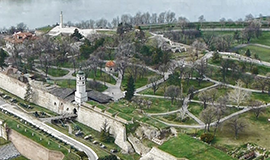Unique in their architecture...Monasteries of Serbia
Krusedol Monastery - The monastery is the legacy of the last Serbian despot family of Srem-Brankovic. It was built between 1509 and 1514. The whole family including Djuradj Brankovic and Stefan Lazarevic, as well as two patriarchs of the Serb Orthodox Church, were buried in Krušedol. It is shown on the 5 Dinar coin.
Grgeteg Monastery - situated in the south of Fruška Gora very close to the village of Grgeteg. The monastery church is dedicated to Saint Nicholas. According to popular tradition it was founded by Despot Vuk Grgurević (known as Zmaj Ognjeni Vuk) in 1471.There are many other monasteries: Staro Hopovo, Novo Hopovo, Velika Remeta, Jazak, Mala Remeta…
Oplenac – the Mausoleum of the Serbian Royal Family Karadjordjevic, located on top of the Hill Oplenac in town of Topola. The Foundation in Oplenac is named after King Peter I. Apart from the two tombs inside the church (Karadjordje’s in the southern and King Peter I in the northern apse), there are 20 other members of the Dynasty whose eternal place of rest is in this Mausoleum. Six generations of the Karadjordjevic family have been buried in this church. Zica monastery, an early 13th century Orthodox Serb monastery near Kraljevo, Serbia. The monastery, together with the Church of the Holy Dormition was built by the first King of Serbia, Stefan the First Crowned and the first Head of the Serbian Church, Saint Sava. Zica Monastery was the seat of the Archbishop (1219–1253), and by tradition the coronation church of the Serbian kings, although a king could be crowned in any Serbian church, he was never considered a true king until he was anointed in Zica. Zica Monastery was declared a Cultural Monument of Exceptional Importance in 1979, and it is protected by country.
Get in touch with Serbian history
Zica monastery, an early 13th century Orthodox Serb monastery near Kraljevo, Serbia. The monastery, together with the Church of the Holy Dormition was built by the first King of Serbia, Stefan the First Crowned and the first Head of the Serbian Church, Saint Sava. Zica Monastery was the seat of the Archbishop (1219–1253), and by tradition the coronation church of the Serbian kings, although a king could be crowned in any Serbian church, he was never considered a true king until he was anointed in Zica. Zica Monastery was declared a Cultural Monument of Exceptional Importance in 1979, and it is protected by country. In 2008, Zica celebrated 800 years of existence.
The Studenica monastery is a 12th-century Serbian Orthodox monastery situated 39 km southwest of Kraljevo, in central Serbia. It is one of the largest and richest Serb Orthodox monasteries. Stefan Nemanja, the founder of the medieval Serb state, founded the monastery in 1190. The monastery's fortified walls encompass two churches: the Church of the Virgin, and the Church of the King, both of which were built using white marble. The monastery is best known for its collection of 13th- and 14th century Byzantine-style fresco paintings. Studenica was declared Monument of Culture of Exceptional Importance in 1979, and it is protected by Republic of Serbia, and in 1986 UNESCO included Studenica monastery on the list of World Heritage Sites.
Get in touch with Serbian history through this amazing 7 day monastery visits.

